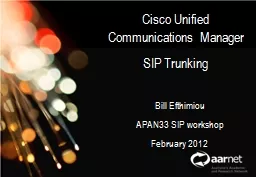

Cisco Unified Communications Manager SIP Trunking Bill Efthimiou APAN33 SIP workshop February 2012 Agenda 2 Basic CUCM setup Partitions Calling Search Spaces Number Manipulation SIP ID: 141063
Download Presentation The PPT/PDF document "Network Operations" is the property of its rightful owner. Permission is granted to download and print the materials on this web site for personal, non-commercial use only, and to display it on your personal computer provided you do not modify the materials and that you retain all copyright notices contained in the materials. By downloading content from our website, you accept the terms of this agreement.
Slide1
Network Operations
Cisco Unified Communications Manager
SIP Trunking
Bill EfthimiouAPAN33 SIP workshopFebruary 2012Slide2
Agenda
2
Basic CUCM setup Partitions
Calling Search Spaces Number Manipulation SIP trunking Early offer vs Delayed offer Demo call via workshop SIP server.Slide3
Basic CUCM Setup – Activate required services
3Slide4
Basic CUCM Setup – Cisco Unified CM
4
Auto RegistrationSlide5
Basic CUCM Setup – Cisco Unified CM Group
5
Redundancyprimary vs secondarySlide6
Basic CUCM Setup – Phone NTP References
6Slide7
Basic CUCM Setup – Date/Time Groups
7Slide8
Basic CUCM Setup – Locations (Call Admission Control)
8
Use locations to implement call admission control in a centralized call-processing
system. Call admission control enables you to regulate audio quality and video availability by limiting the amount of bandwidth that is available for audio and video calls over links between the locations.Slide9
Basic CUCM Setup – Device PoolSlide10
Basic CUCM Setup – Enable CDRSlide11
Basic CUCM Setup – Media Resource GroupSlide12
Basic CUCM Setup – Media Resource Group List
12Slide13
CUCM Partitions
The dial plan entries that you may place in a partition include IP phone directory numbers, translation patterns, route patterns, CTI route points, and voicemail ports. If two or more dial plan entries (directory numbers, route patterns, or so forth) overlap, Unified CM selects the entry with the closest match (most specific match) to thedialed
number. In cases where two dial plan entries match the dialed pattern equally, Unified CM selects the dial plan entry that appears first in the calling search space of the device making the call.Source: Cisco Unified Communications System 8.x SRNDSlide14
CUCM Calling Search SpacesA calling search space defines which partitions are accessible to a particular device. Devices that are assigned a certain calling search space can access only the partitions listed in that calling search space. Attempts to dial a DN in a partition outside that calling search space will fail, and the caller will hear a busy signal. If you configure a calling search space both on an IP phone line and on the device (phone) itself, Unified CM concatenates the two calling search spaces and places the line's calling search space in front of the device's calling search
space.
Source: Cisco Unified Communications System 8.x SRNDSlide15
CUCM – Partition Order
15
Source: Cisco Unified Communications System 8.x SRNDSlide16
CUCM – Concatenation of Line and Device CSS
16
Source: Cisco Unified Communications System 8.x SRNDSlide17
Number Manipulation
– Route PatternSlide18
Number Manipulation – Translation PatternSlide19
Number Manipulation – Route List DetailSlide20
SIP
Trunking
– CUCM 8.5
SIP trunks provide connectivity to other SIP devices such as gateways, SIP proxies, applications, and other Unified CM clusters. Today, SIP is arguably the most commonly chosen protocol when connecting to service providers and Unified Communications applications. Cisco Unified CM 8.5 and later releases provide the following SIP trunk and call routing enhancements:• Can run on all Unified CM nodes• Up to 16 destination IP addresses per trunk• SIP OPTIONS ping keepalives• SIP Early Offer support for voice and video calls (insert MTP if needed)• QSIG over SIP• SIP trunk normalization and transparency• Supports the use of route lists on all Unified CM nodesThe SIP trunk features available in the current release of Unified CM make SIP the preferred choice for new and existing trunk connections.
Source: Cisco Unified Communications System 8.x SRNDSlide21
SIP Trunk Configuration –
8.0Slide22
SIP Trunk Configuration –
8.0 (continued
)Slide23
SIP Trunk
Security ProfileSlide24
Delayed offer
vs
Early offer
Delayed offer = NO SDP in original SIP INVITE Early offer = SDP included as part of original SIP INVITE With delayed offer, caller makes the final codec decision.
With early offer, called makes the final codec decision.
Prior to CUCM version 8.5, SIP trunk only supported delayed offer.
AARNet’s
experience with delayed offer was, issues when calling MCUs.
MCU’s support many codec’s. Therefore, the responding SIP/SDP body,
i
s very large and causes massive fragmentation issues.
Signaling
or
n
egotiation would often fail.Slide25
Delayed offer- trace
25Slide26
26
Early offer- traceSlide27
27
CUCM Early
Offer enabled
Copy “Standard SIP Profile”Standard SIP Profile Standard SIP Profile- w early offer.Slide28
28
CUCM Early
Offer enabled
<snip>Slide29
29
Thank you
Questions?